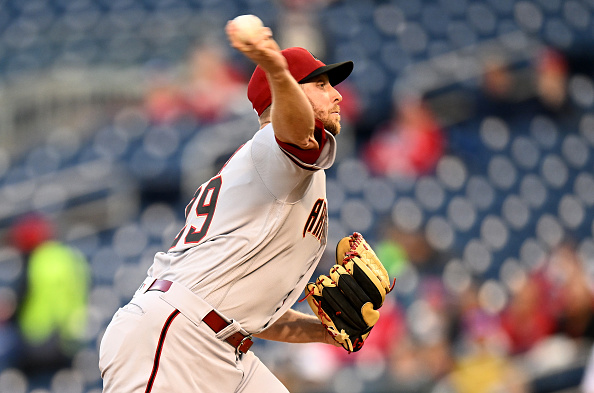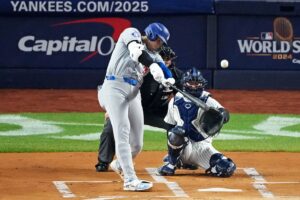Diamondbacks Pitching Is Off to a Great Start Overall
The Arizona Diamondbacks have stumbled to a 4–8 start, but this is not at all the fault of the pitching staff. They have been so ineffective at the plate that they have, seemingly, been trying to win games with a figurative score of 0–0. Outliers on the pitching staff have also overshadowed the truly remarkable starts several of their pitchers have had.
(Before continuing, some housekeeping. We will use ERA-minus in this piece. ERA-minus takes ERA, adjusts it for the team or player’s home ballpark, and divides it by the league-wide ERA. This does two things. First, it takes away any advantage teams have if they play in a pitcher’s park. A 3.00 ERA is far more impressive in Colorado than it is in San Diego, for example. Secondly, it compares an ERA to the league average, which quickly answers the question of “is that good?”
ERA-minus has no decimal places. The lower the number, the better. Anything under 100 is lower than the league average; anything above is higher. An ERA-minus of 50 means that the pitcher’s park-adjusted ERA is half as high as the league average. Back to the analysis.)
Diamondbacks Pitching: General Overview
Hiring pitching coach Brent Strom this past offseason raised eyebrows around the league. The general thought around the league was that Strom, widely regarding as the best pitching coach in today’s game, was retiring. But, instead, Strom took a job with the Diamondbacks. When hired, Strom said in his introductory press conference that the Diamondbacks had a lot of unrealized potential.
Strom’s tutelage has paid off in the early going. As a staff, the Diamondbacks are sixth in the National League in ERA-minus. The only teams ahead of them are the Los Angeles Dodgers, San Francisco Giants, New York Mets, St. Louis Cardinals, and San Diego Padres. Their ERA-minus (89) over these first 12 games is the eighth-best start in team history. It is also the best since 2018 (64) and second-best since 2012 (86).
Diamondbacks Starting Pitching
Looking at splits between starters and relievers changes the numbers a little bit. As a unit, the Diamondbacks starting pitchers have an ERA-minus of 63. That is third-best in the NL, trailing only the Mets and Dodgers.
However, there is more to the story. Caleb Smith, who was recently sent to Triple-A, has had a disastrous start to the season. In his lone start, he gave up four earned runs in one inning-plus. Removing Caleb Smith — the outlier — from the starting rotation statistics makes the team’s ERA-minus 46, which would lead the league.
Diamondbacks Relief Pitching
The relievers have also been good as a whole. Yes, their reliever ERA-minus is 116, which is 14th out of 15th. But, again, there’s more to it than what appears on the surface. Of the 26 earned runs given up by the relief corps, 10 have come from two pitchers — Caleb Smith and Oliver Perez. Smith gave up five earned runs in three innings during his lone relief appearance. Perez has given up five earned runs in 3 1/3 innings across five appearances. Removing Smith and Perez from the relief statistics brings their ERA-minus as a relief unit down to 83, which would put them eighth in the NL. It would also raise their scoreless outing percentage to 64.1%.
Notable Performers
Some of the individual performances are even more impressive. Madison Bumgarner, in his three starts, has an ERA-minus of 36. By comparison, the record for an entire season is 35, set by Pedro Martinez in 2000 (1.74 ERA; 4.91 league avg). The NL record is 37, set by Greg Maddux in 1994 (1.56 ERA; 4.21 league avg). Bob Gibson’s legendary 1968 season, where he posted an ERA of 1.12 in a year where the league average was 2.99, gave him an ERA-minus of 38. (Editor’s note: Yes, this is three starts versus well over 30, but it’s still a fun comparison.)
Merrill Kelly, in Wednesday night’s start, gave up an earned run for the first time all season. One earned run in 15 1/3 innings equals an ERA of 0.59 and an ERA-minus of 15. Obviously, that is not sustainable for the entire season, but it is still fun to look at the current hot streak.
Several relievers are also doing extremely well so far. Lefties Joe Mantiply and Kyle Nelson each have yet to give up any runs. J.B. Wendelken has a 1.93 ERA and 50 ERA-minus to go with a 75% scoreless outing percentage in four appearances. Mark Melancon, in four innings, has given up one earned run. This gives him a 2.25 ERA and 59 ERA-minus. Sean Poppen, in six innings across five appearances, has given up one earned run total. This gives him a scoreless outing percentage of 80% to go with a 1.50 ERA and 39 ERA-minus.
Outlook
There are other areas that are showing promise. The staff is giving up extra-base hits at a rate below the league average. When removing Caleb Smith from the equation, the starters are giving up an extra-base hit on 32% of their hits. The league average is around 34%. The relievers are giving up extra base hits on only 25% of their hits, seven percentage points below the league-wide relief average of 32.3%.
Given the team’s hitting woes, they could easily be winless at this point. Instead, they are 4–8. In three of those wins, the difference was outstanding pitching. As we know, no one can win a game 0–0. Once the run support kicks up, if the pitching staff continues to pitch well the team should be in good shape. We know their numbers will get closer to the league average, since keeping their current level of performance would not only set new records but would shatter the old ones. But even a normal regression to the mean would translate to more success than the team has seen in recent years.
Main Photo:
Players/Coaches Mentioned:
Brent Strom, Caleb Smith, Oliver Perez, Madison Bumgarner, Pedro Martinez, Greg Maddux, Bob Gibson, Merrill Kelly, Joe Mantiply, Kyle Nelson, J.B. Wendelken, Mark Melancon, Sean Poppen






